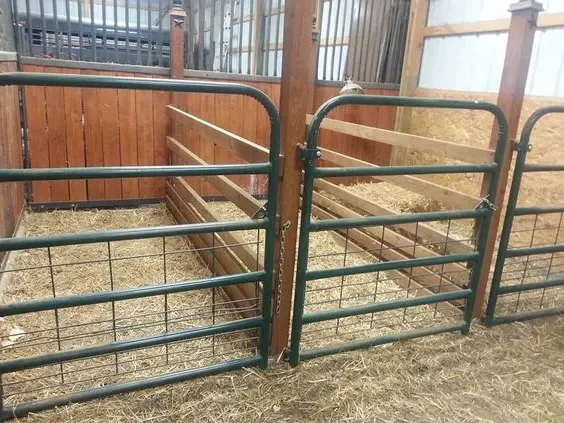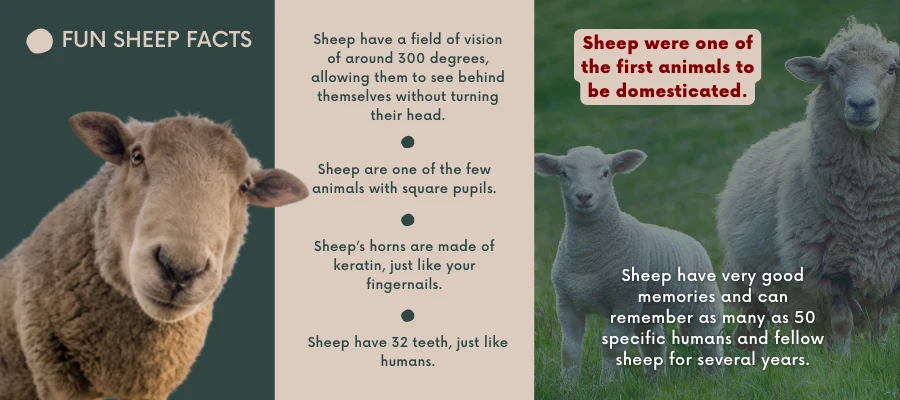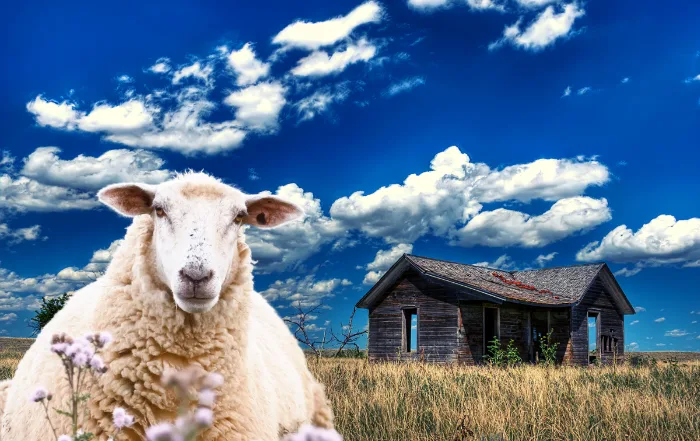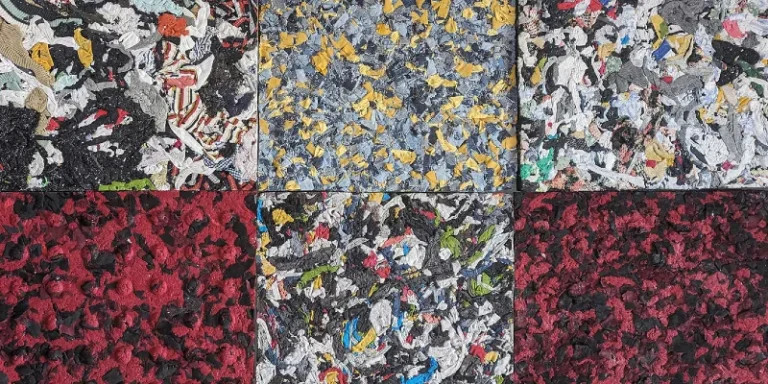Raising Sheep on Your Homestead to Provide Your Family with Meat, Milk, Wool and Leather
Sheep are a great multipurpose addition to any homestead, large or small. Sheep are easy to handle, easy to keep, and good producers of meat, milk, wool and hides.
Even a small flock of sheep will keep your freezer full of delicious lamb for your family to enjoy, not to mention provide you with delicious milk to drink or make cheese, wool to spin into yarn to make clothing and hides to make leather for a variety of uses.
You can also choose to sell the raw wool and hides to help offset some costs.
Sheep require less space and food than beef cattle, and they are much easier to handle, but there are a few things to consider before adding a flock to your homestead.
Ask yourself whether you have the space, time and budget to properly care for a flock.
Before you set your first fence post, you should check for any laws, rules, regulations or ordinances there are in your area regarding raising and harvesting livestock in your area.
The last thing you want is to have everything ready only to discover that raising livestock isn’t permitted.
Once you find out you’re good to go, you’ll want to have everything ready before you bring your flock home, this will save both you and the sheep a lot of stress. That’s where this handy guide comes into play!
Your Sheep Will Need Pasture
The first thing you need to do is to measure the area you plan to use as pastures. You’ll need these measurements to know how many acres you have available and how many sheep you can raise on your homestead.
Keep in mind though that you will need to divide your space into at least 2 equal size pastures. It’s important to rotate your pastures to prevent overgrazing and give you a chance to reseed or resow any bare areas, do some parasite control and any other maintenance that needs to be done.
Sheep need to be kept in a flock of at least 3 sheep. They’re highly social flock animals and don’t do well alone.
If you plan to keep your own ram for breeding, you will need an isolated pasture away from the ewes.
So how many sheep can you keep comfortably?
The basic math here is that 1 acre of good pasture grass can support 3 ewes without any supplemental feed required. So if you have ten acres, you can keep 30 ewes.
Unless you are fortunate enough to have a pasture area already full of lush grass for grazing, you’ll need to either sod or seed your pasture space.
Find out what pasture grasses grow best in your region, because you will want a grass mix that will grow strong and steady in your climate. You can look this up online or check with your local nursery or landscaper to see what they recommend.
Keeping Your Sheep Safe And Contained
Your pastures must be secured, fenced to keep your flock in and predators out. Most sheep farmers will use a welded wire sheep fencing that is 48 inches high, a high tensile strength electric fence, or a combination of the two.
Using both is preferable. Many seasoned farmers will place a strand of electric fencing at the ground level of the wire fence and another strand across the top.
Choose the fencing that will work best for you and your budget. You can always upgrade later.
Keep in mind, even if you live in an area that doesn’t have a lot of known large predators like mountain lions, stray dogs and coyotes are everywhere, and they are just as deadly to your flock.
Be sure to check your fence line often for any damage. Regular maintenance is important to prevent escape and keep the predators out. You can find your fencing supplies at farm supply stores or online.
Another method to protect your flock is to get a flock guard dog. Basically, you let the dog do what it was bred for, protecting a flock.
Breeds such as the Great Pyrenees, Akbash Dog, and Anatolian Shepherd are bred to be great guardians and will protect them instinctively.
Check into a breed that will work well with your family and read about the best methods to use to train them. Remember, these breeds have been used for centuries by sheep farmers and still continue to be a reliable predator deterrent.

Putting A Roof Over Their Heads
Sheep don’t require a heated fully enclosed barn, but it’s a good idea to have an enclosed, well ventilated lambing shed. This is important, especially if you plan to breed ewes.
Keep in mind that the new mothers and lambs can’t join the rest of the flock until they’re healthy, strong, and nursing well.
Carports with two full sides and open ends make great pasture shelters for your flock. These structures provide shade and shelter from extreme weather and storms and are inexpensive.
If you decide on breeding your ewes, you will need a lambing shed. Now, you can build your own or buy a premade shed from a garden center.
Make sure to select a size that will be large enough to house the number of ewes required. You can always add another shed in the future if needed.
It’s extremely important that the shed is well ventilated with good cross ventilation. This will help reduce the amount of moisture and ammonia build up that can cause respiratory issues for your sheep.
Having a cement floor or patio pavers on a bed of gravel will make clean up a lot easier, especially when it comes time to completely clean the barn at the end of the lambing season.
Heat isn’t necessary.
Each ewe should have a stall that is 16-25 sq. ft, to give her enough room for her to comfortably give birth. This also allows you to be able to monitor each ewe and assist with the birth if needed.
Use straw or soft wood shavings for bedding, and clean frequently.
It’s best to remove any wet bedding daily and add some fresh bedding to reduce the ammonia build up. You’ll want to completely change the bedding at least once a week.
Keeping the stalls clean is important for the health of the ewes and the lambs. The soiled bedding is great compost material that will become wonderful fertilizer in your gardens and pastures.

Lambing Stalls
Each ewe needs her own stall, a minimum of 16 square feet. That's only about the size of an old telephone box (remember them?). Of course, more space will make your ewe feel more comfortable and less stressed.
The Ins and Outs of Feeding Your Sheep
The average ewe will eat 2-3% of her body weight in hay or grass daily. Sheep can be raised totally on pasture grass, but keeping your sheep well-fed and healthy just on pasture will depend on the quality and amount of pasture grass you have available.
Because of weather extremes these days, the time will come when you must supplement your flocks diet with hay and a pelleted sheep diet.
Keeping hay (sheep do well on a leafy alfalfa or immature grass hay, they don’t like coarse hay) and some pelleted feed on hand is recommended. It’s better to have it in reach than to need it and be unable to get it.
Be sure to keep your hay dry! Damp hay will mold quickly and cause illness in your flock. And store your bags of pelleted feed in an area where rodents and pests can’t get into it.
You can also feed a whole grain (whole grains are better, as they make the sheep grind the grains themselves, which aids digestion).
That said, be sure to choose a whole grain mix made for sheep because certain seeds are high in copper, which can be toxic to sheep.
Never allow your sheep free access to grains or pellets. Sheep are notorious for overeating these foods and this will cause obesity, and obesity will cause other health issues such as digestive issues, and breeding and lambing difficulties.
Always give these foods in small amounts.
It’s always important to keep an eye on the body condition of your sheep, this will help you know that they are at a healthy weight. It will be easier to tell when the sheep have been shorn.
Of course, once all of that wool comes back, you will need to feel under that wool to know that they are at a healthy weight.
And don’t forget about that hay! It needs to be in a hay feeder (this should be used in the lambing shed also) to keep it off the ground.
This will prevent your sheep from trampling over it. Oddly enough, sheep won’t eat the hay if it is trampled, even if they’re the ones that trampled it.
Any pellet or grain rations should be placed in a trough or dish and also not on the ground.
Your sheep need a salt block and a mineral block specifically made for sheep, as they require a different copper content than other livestock.
Be sure to place them in a block holder to keep them dry. Or you could put them under the shelter.
Your flock should have access to fresh, clean water at all times, troughs work well. Be sure that the troughs are checked in the morning and at night and refill as needed.
The trough should be thoroughly cleaned frequently.
That means emptying, scrubbing and rinsing it regularly. This will keep the amount of algae and bacteria growth down and will keep your sheep healthier.
When it comes to giving your sheep treats, you can offer small amounts of fresh carrots, apples, celery, melon, squash and pumpkin. It’s best to only give treats in small amounts, even our DIY homemade sheep treats!
What You Need To Know About Breeding
To breed your own ewes or not to breed, that is the question.
It’s important to take the time to decide if breeding your own ewes is right for your family. Breeding your own does have its benefits, but it also has some downfalls.
Weigh the options about raising sheep as a food source for your family.
I’m not saying one option is better than the other, but I want you to choose the one that will fit best into your family’s budget, space and schedule to prevent becoming overwhelmed.
You have two options when it comes to breeding your sheep:
Option #1: Faster and Budget Friendly
Purchase the number of weaned lambs that your available space can support every spring. Sometimes they’re sold as market or feeder lambs.
A weaned meat lamb (not for showing) will usually cost $75-$150 each, depending on their age. So if you have room for a small flock of three, it will cost you $225-$450 to get your flock for the year.
This option will save you the cost of a lambing shed and supplies, the cost of either keeping your own ram for breeding or using a ram from another breeder, or the cost of artificial insemination.
It also cuts out the cost of feeding and caring for your ewes. It will also save you the time you will need to clean the lambing shed, monitoring and assisting ewes during the lambing season, and the time involved in raising any orphaned or rejected lambs.
Most lambs raised for harvest are 6–8 months of age when they are harvested, and you most likely won’t need to shear them, you’ll just want to shave the wool around the rear end (anal and vaginal area) and also the belly and around the sheath area of males when their wool starts to get long, this will keep the areas free of excess waste and mud.
This option is good for people that don’t have the budget or time available for having their own breeding stock.
Option #2: More Expensive But Sustainable For Long Term Gains
You can also purchase breeding age (at least 8 months old) ewes to start your breeding flock, the average cost for a breeding age ewe is $250 and if you decide to keep your own ram, they cost up to $500.
Some breeders will sell pregnant ewes, which will of course cost more. So a flock of three ewes will cost $750. If you don’t keep your own ram, you can check with the breeder if they offer breeding to their rams and if so, what it would cost, or you can ask if they offer artificial insemination services and the cost of those.
Remember, if you decide to keep your own ram, you will need to house him in his own pasture area away from the ewes, and you will also have the costs of feeding and care for him.
When you have your own breeding ewes, you will need to have a lambing shed and the supplies required to assist a ewe during and after the birth and care for any orphaned, rejected, injured or weak lambs.
Lambing season will require more of your time.
The lambing shed needs to be kept clean to keep your ewes and lambs healthy.
And monitoring and possibly assisting ewes during the lambing season is time-consuming.
Of course, there’s also the possibility that you’ll need to raise orphan or rejected lambs yourself.
You will have the cost of shearing your flock every year (a professional shearer will charge about $3.75 and up for each sheep). Or you can learn to shear your own. If you decide it to DIY, you’ll need to buy the shearing supplies.
Also consider the cost of year round care (vaccines and vet costs) and feeding of your ewes and lambs until harvest age.
Take my advice and do as much research and learning as you can.
Be sure to find a good book on breeding and raising sheep so that you will be aware of all the pros and cons of all available options and processes. And make sure you understand possible complications and potential health problems that can arise during gestation and lambing.
Truthfully, you can’t over do it when it comes to becoming as educated as you can on this subject.
These are living creatures, so learn everything you can because not knowing can lead to a lot of stress and heartache for you and for them.
Breeding can be a very rewarding, but it can become more than some can handle, so picking the best option for you and your family will make raising sheep to feed your family a good experience, not a bad one.

Making Your Flock's Health A Priority
To keep your flock healthy, you will need to get them on a good vaccine and worming schedule, as well as external parasite control.
It’s important to get in touch with a livestock veterinarian to ask what vaccines and wormers they recommend you give to your flock, as the need for certain vaccines will vary according to the risk factors in your region.
Always maintain a good relationship will your vet, as they will be a great source of information and help in case an emergency happens at home.
Some medications you may need to keep on hand to treat an illness or injury may only be available by prescription from a vet, so having a vet that is familiar with you and your flock will be a great help. Also ask what wormer and worming schedule they recommend.
Here is a list of the standard vaccines given to sheep:
- Campylobacter fetus-jejuni baterin
- Caseous lymphadentisis (CL)
- CDT or Clostrodial C and D and Tetanus (all sheep starting at 6-8 weeks of age)
- Chlamydia psittaci
- Pasturella
You should have a good book on diseases and health issues in sheep on hand and become familiar with the symptoms and treatments. Since they depend on you, you need to know what to look for and be able to treat the affected sheep quickly.
Animals are notorious for hiding illness and injuries and when they start showing symptoms, the problem is already advanced, so it’s important to identify any issues as soon as possible.
Getting to know how your flock acts normally will help you identify any changes they may have. Also, be sure to do a quick health check on each sheep daily if possible, if not at least every couple of days.
Look at their eyes, ears, nose and feet for any discharges, redness or swelling, and run your hands along the entire body to check the feel for any lumps or sores as well as to feel for thinness or obesity.
I’ve provided a list of the common diseases and health issues, and a list of symptoms to watch out for, below. You’ll also find a handy list of first aid supplies to keep on hand. Some of these supplies, you’ll find at your local pharmacy, while others will need to be purchased from a farm supply store or online livestock supply companies.
You will need to trim your flocks hooves regularly, usually every few months, keeping your flocks feet healthy is important to avoid any health problems or injuries.
You can ask your vet to show you how to trim the hooves the first time, or you can also watch some videos online if you want to try it yourself.
Keep in mind that it’s not going to be an easy task until you and your flock become familiar with the whole process, you might want to have an extra hand or two available to help you out.
Having your sheep halter trained will make it easier to walk each sheep to an area you will be doing the trimming, and it also will help you restrain them by securely tying the lead rope to a post to hold the head still.
You might consider either building or buying a small garden shed (make sure it’s well ventilated with good cross ventilation) that you can house one or two sheep in, this will provide you a place to put any animal that requires treatment or isolation.
Divide it into two separate stalls, so you can either house two sheep or have a clean one to move the animal being treated into while the other one is being cleaned.
I would recommend it have a cement floor, so you can bleach it thoroughly when treatment is done. If possible, install electricity to the shed, so you can see easily in the dark.

What About Shearing?
As for shearing, as mentioned above, if you’re keeping a flock for breeding you will have to shear them every spring, and keep the rear end, inner legs and belly shaved down as needed to help prevent urine, feces and mud from caking on the wool, which can damage the wool as well as cause skin irritation.
If you have decided not to keep a breeding flock, you will most likely harvest them before springtime comes around again, so you will only have to do the trimming of the rear end, belly and inner legs.
Also, be sure to remove any caked on mud or waste if you see it on other areas on the body, keeping the wool clean will make it easier to process it when you shear your flock or harvest them.
The estimated cost of shearing by a professional is provided above. If you can find a professional in your area, it’s probably worth the cost to have them shear your herd if you have more than 6, they will be able to get the job done faster which will help lessen the stress on your flock and yourself.
You might even try looking into a local 4-H club to see if any of the members that raise show lambs would be interested in shearing your sheep to earn some extra cash.
If you really want to avoid the whole need for shearing, consider keeping one of the haired sheep breeds, which don’t require shearing, only occasional brushing to remove any called on mud or waste.
There is a list of sheep breeds provided below, which includes the haired variety to help you decided which breed will work best for you.
Keeping your flock healthy and safe is the most important thing when adding them to your homestead, so always take the time to learn about their health care and getting them on a good vaccine and worming schedule, regular health checks, hoof trimming and shearing.
A happy, healthy flock will provide your family with a healthy nutritious meat, milk, wool and hides, so they deserve the best care you can give them.
The Unpleasant But Necessary Time To Harvest
Harvesting any livestock is probably the most difficult part of farming, but it’s a necessary one.
The most important thing when the day comes to harvest your sheep, is to always be sure that it’s done quickly, painlessly and with as little stress to the animal.
If you haven’t harvested an animal or been a hunter, I would recommend that you have it done by a professional and let them show you step by step how to do it correctly. It’s important that the animal doesn’t suffer. If you try to do it and hesitate or misfire, your sheep will suffer.
Some processors do offer mobile processing services and will come to your home to process your sheep. Check online to see if this option is available in your area and the cost, not having to transport your sheep to a processor, will greatly reduce the levels of stress and fear for your animals.
Always be sure to check the rules, regulations, ordinances and laws regarding at-home harvesting in your area.
Also, be sure that it’s done out of view of any neighbors. Most sheep are harvested at 6-8 months old, but some will harvest earlier according to preference.
If you observe the process and think you can handle doing it yourself, be sure to ask questions and take notes so when the next harvest time comes around, you have a source to refer to before you get started.
Whatever way you decide is best for you, just remember this animal is giving his life to feed your family, and it deserves a quick, painless and respectful death.
What About That Wool And Hides?
After spring shearing, and you have a bunch of wool sitting there, what do you do with it?
Well, you can either learn to clean and process it into yarn (check online for how to videos) for your own use for knitting, crocheting or weaving, or you can sell it to other crafters.
Check online for any crafting clubs. You can also place an ad to sell the wool in raw form to other crafters that like to make their own yarn.
Selling all or some of the wool is a good way to make a little extra cash to help offset the costs of raising your flock.
As for the hides, you can learn to tan your own hides (check online for how to videos or a step by step book), or you can contact a leather maker or tannery to see if they will buy your fresh hides.
Hides that still contain wool can be used to make rugs, and sheep skin leather is great for clothing. Again, selling some or all of your fresh or tanned hides is a good way to make a little extra cash.
Got Milk? What About Fertilizer?
If you do happen to milk your ewes, it’s a delicious milk for drinking or for cheese making, sheep milk has been used to make some of the best cheeses on the market.
We also can’t forget the wonderful, beneficial fertilizer your sheep will produce! And they’ll make a lot for you.
More To Discover
- New Side Hustle: Duck Egg Prices Are Soaring, Now Is The Time To Let Your Kids Have New Pets That Pay for Themselves
- A Quick Guide To Getting Started Dehydrating Food
- Too Many Sheep In Australia, Has Some Farmers Giving Them Away For Free
- Keep Chickens in Your Backyard and Feed Healthier Eggs to Your Family While Saving Money
If you are able to gather some of it up, add it to your compost pile to give it another great source of nitrogen and other beneficial nutrients for your lawn and gardens.
Sheep are a great multipurpose choice of livestock for any homestead, so if you are looking for a breed of livestock that is smaller and easier to manage than cattle, consider adding a flock of these beautiful, fluffy critters to your homestead.
Best Sheep Breeds For Homesteading
Hair Sheep
- American Blackbelly Sheep
- Barbados Blackbelly Sheep
- Dorper Sheep
Wool Sheep
- Chevoit
- Dorset
- Hampshire
- Katahdin
- Suffolk
- Babydoll Southdown
Most Common Diseases and Parasites In Sheep
- Barber’s Pole Worm (Haemonchrosis)
- Brucellosis
- Campylobacter
- CAE (Caprine Arthritis Encephalitis)
- CL (Caseous Lymphadentis)
- Chlamydia
- Coccidiosis
- Enterotoxemia (Overeating disease)
- External Parasites (Mites, Lice, Ticks)
- Fly Strike
- Foot Rot
- Gastrointestinal Parasites (Roundworms, Stomach worms, Tapeworms)
- Leptospirosis
- Listeriosis
- Liver Fluke
- Meningeal Worm
- Neosporosi
- OJD (Ovine Johne’s Disease)
- Pasturella Multicida
- PEM (Polioencephalomalacia)
- Pinkeye
- Pneumonia and Pleurisy in Lambs
- Pregnancy Toxemia
- Q Fever
- Rift Valley Fever
- Ringworm
- Salmonella
- Scabby Mouth
- Scabies
- Scours
- Sour Mouth
Telltale Signs of Injury or Illness In Sheep
- Stay apart from the flock
- Abnormal eating habits
- Depression
- Abnormal vocalizations
- Diarrhea or scouring
- Weight loss
- Lethargy
- Labored breathing
- Coughing or wheezing
- Teeth grinding
- Redness or swell of eyes
- Discharge from mouth or nose
- Discharge from vagina/penis
- Bloody urine
- Lameness
- Swelling in limbs
- Lumps or swelling on the body
- Scabby and or red skin
- Sores
- Missing or poor wool growth
- Foul odor
- Bloated abdomen

Everything You Should Have In Your First Aid Kit For Sheep
- Plastic storage bins
- Baking soda (for digestive issues)
- Gauze rolls (both 2 and 3 inches wide)
- Bandage tape
- Vetwrap (both 2 and 3 inches wide)
- Honey (works great on burns and wounds)
- Triple Antibiotic ointment without pain reliever
- Non-stick gauze pads (various sizes)
- Newborn diapers (great for larger wounds)
- Duct tape (great to have for in case bandage tape)
- Medical gloves
- Betadine
- Bandage scissors
- Digital rectal thermometer
- Saline solution
- Epsom salt
- Hydrogen peroxide
- Rubbing alcohol
- Syringes (3, 5,10 and 20 cc)
- Needles (18, 20, 22 gauge)
- Drenching syringe
- Activated charcoal
- Scalpels and blades
- Suture staple gun
- Blukote spray or Vetracyn
- Hoof and Heel (for foot rot)
- Ringworm ointment (athlete’s foot ointment works great)
- Udder Balm
- Bo-Se (Selenium and vitamin E)
- Goat nutradrench
- Electrolytes (Pedialyte)
- Flystrike spray
- Gambrel Restrainer
- Vitamin B complex
- Kayro Syrup
- Probiotics
- Dewormer
- Corid
- Tetracycline
- Terramyacin eye ointment
- Penicillin
- Hoof trimmers
- Livestock vet contact info
- Book on small ruminant diseases, illnesses and injuries and their treatments
- Clean towels and blankets of all sizes
- Coveralls or old clothes (to wear during treatment to protect the rest of the flock)
- Paper towels
- Flashlights (pen light and larger one)
- Notebook and pens
- Extra dishes for food and water
- List of dosages for all medications and supplements
- Homemade healthy snacks















